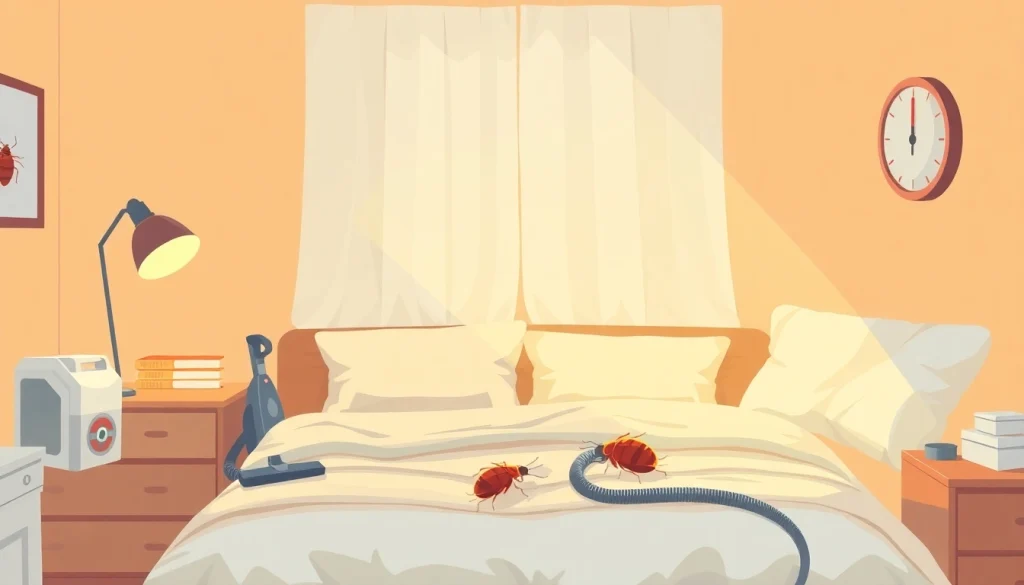
Understanding Bed Bugs
Bed bugs have become a notorious pest in homes and establishments across the globe. Their ability to easily spread and multiply has made understanding and mitigating their presence more crucial than ever. These tiny, nocturnal insects bite human hosts to feed on their blood, leaving itchy, red welts that often cause distress and anxiety. This article will delve into effective bed bug control strategies, prevention techniques, and provide guidance on when to seek professional help.
What are Bed Bugs?
Bed bugs are small insects belonging to the Cimex lectularius species. Adult bed bugs are roughly the size of an apple seed, measuring about 5-7 millimeters in length. Their flat, oval bodies make it easy for them to hide in tight spaces such as mattress seams, behind headboards, and in furniture crevices. Bed bugs are reddish-brown in color and become more swollen and reddish after feeding. Unlike many other pests, they do not fly; instead, they crawl quickly and can be transported in luggage, clothing, or furniture, leading to infestations in unsuspecting homes.
Signs of Infestation
Detecting bed bugs early is vital for effective control. Common signs of infestation include:
- Visible Bugs: Adult bed bugs or their shed skins may be seen on bedding, mattresses, or surrounding areas.
- Bite Marks: Red, itchy welts on exposed areas of skin, typically appearing in a line or cluster.
- Stains: Small dark spots on bedding, which are bed bug feces or blood stains from crushed bugs.
- Odor: A musty smell may indicate a larger infestation, as bed bugs release pheromones.
Why Bed Bug Control is Crucial
Effective bed bug control is critical not only for comfort but also for mental well-being. Bed bugs can cause significant psychological effects, including anxiety, insomnia, and stress. Moreover, infestations can lead to economic ramifications from extermination costs and damage to property. Understanding their rapid reproduction rates—where a single female can lay hundreds of eggs in her lifetime—underlines the importance of immediate action when signs of bed bugs are detected.
Prevention Techniques
Preventing bed bugs is often more feasible and cost-effective than managing an infestation. By implementing proactive strategies, homeowners can minimize the risk of encounters with these pests.
Keeping Your Home Bed Bug-Free
To keep bed bugs at bay, consider the following methods:
- Regular Cleaning: Frequent vacuuming of carpets, rugs, and upholstery can significantly reduce bed bug presence. Pay special attention to seams, edges, and corners.
- Decluttering: Minimizing clutter in living spaces reduces potential hiding spots for bed bugs.
- Protective Covers: Encase mattresses and pillows with bed bug-proof covers to create a barrier and prevent bed bugs from penetrating.
Safe Travel Tips to Avoid Bed Bugs
The transient nature of travel increases the risk of unknowingly bringing bed bugs home. Follow these precautions to avoid bringing these pests back with you:
- Inspect Lodging: Check for signs of bed bugs in hotel rooms upon arrival, particularly around the mattress and headboard area.
- Luggage Management: Keep luggage off the floor and use the luggage rack instead. Additionally, after returning home, unpack directly onto a flat surface and wash clothing in hot water.
Creating a Bed Bug-Proof Environment
Mitigating the risk of infestation involves creating a living environment resistant to bed bugs:
- Seal Cracks: Fill in cracks and crevices in walls, floors, and furniture to limit potential bed bug habitats.
- Smart Furniture Choices: Choose furniture that does not have hollow spaces or gaps where bed bugs can hide.
DIY Bed Bug Control Methods
When faced with a minor bed bug problem, several do-it-yourself strategies can be effective in controlling the situation before it escalates.
Cleaning and Decluttering
The first step in any DIY bed bug control effort is thorough cleaning. This involves:
- Washing Linens: Wash all bedding, linens, and clothing items in hot water and then dry them on high heat for at least 30 minutes to kill bugs and eggs.
- Vacuuming: Use a vacuum cleaner with a HEPA filter to suck up bed bugs from all possible hiding spots. Remember to promptly seal and dispose of the vacuum bag.
Using Heat and Cold Treatments
Temperature is a powerful tool against bed bugs. Use heat treatments at temperatures above 115°F (46.11°C), as bed bugs cannot survive such temperatures. Similarly, exposing bed bugs to extreme cold (0°F or -17.78°C) for a minimum of 4 days can also kill them.
Effective Insecticides and Sprays
If cleaning and environmental adjustments have not produced adequate results, consider using insecticides. Choose those specifically labeled for bed bug control. Common active ingredients include:
- Pyrethroids: Synthetic chemicals effective against adult bed bugs.
- Desiccants: Agents that dry out bed bugs exoskeletons, leading to death.
Always follow safety instructions for any pesticides used, ensuring that the treated areas are ventilated and that children and pets are kept at a safe distance.
When to Call Professionals
Despite diligent DIY efforts, there may come a time when the infestation becomes too severe, necessitating professional intervention.
Signs You Need Expert Help
It’s time to contact pest control professionals if you notice the following:
- Persistent bites and itching despite implementing preventive measures.
- Visible bed bugs or fecal stains spotted in multiple areas.
- Emotional distress or impact on daily living due to the infestation.
Choosing a Pest Control Service
When selecting a pest control service, consider their credentials, experience, and the methods they use. Look for:
- Licensed and insured technicians.
- Experience dealing with bed bug infestations specifically.
- A thorough inspection process and an integrated pest management (IPM) approach that utilizes both chemical and non-chemical treatments.
Understanding Treatment Costs
The cost of professional bed bug extermination can vary widely depending on the severity of the infestation, size of the property, and the techniques employed. Typical costs can range from $300 to $1,500. Consider that investing in professional treatment often saves money in the long run by preventing greater damage and loss.
Maintaining a Bed Bug-Free Space
Once a bed bug infestation has been controlled, maintaining a clean, bed bug-free environment is essential to prevent future occurrences.
Long-term Control Strategies
To protect your home from future infestations, employ these long-term strategies:
- Regular Inspections: Conduct periodic checks in bedrooms and living spaces, particularly after travel.
- Continued Education: Stay informed about bed bug behavior, treatment strategies, and potential new control methods.
Monitoring for Future Infestations
Implementing proactive monitoring strategies helps catch infestations early. Bed bug monitoring traps can be set around legs of beds and furniture to capture any wandering bed bugs before they become a larger problem.
Educating Your Household
Ensure that everyone in the household is aware of bed bug identification signs and prevention strategies. Educating all members, particularly children, will facilitate fast actions in case of any sightings.
In conclusion, bed bug control is a multifaceted endeavor that necessitates a combination of understanding, preventive strategies, and timely responses. By being proactive and informed, you can significantly reduce the risk of bed bugs in your home.






